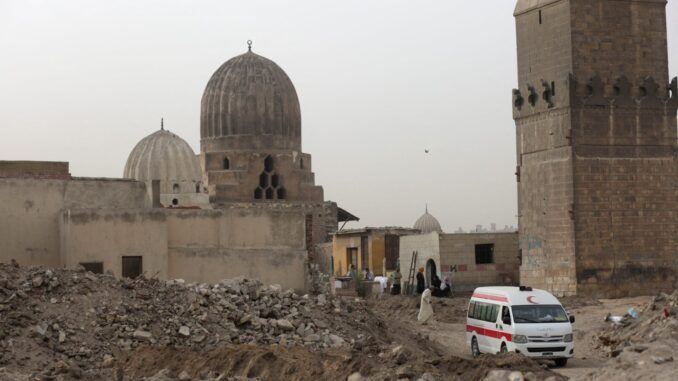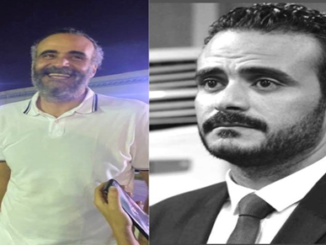
The Egyptian government is killing the history of a historic city of the dead, the famous grave site of Imam al-Shafi’i
Cairo’s City of the Dead—a vast Islamic-era necropolis located at the foot of the Mokattam Hills, a short walking distance from the Cairo Citadel—was, until recently, a burial site boasting an impressive array of historic mausoleums and cemeteries.
Some of the tombs in the complex date back to the Mameluke era of the 1200-1500s. Others serve as the final resting place for scholars, cultural figures, rulers, and members of Egypt’s royal and elite families.
Now, a large part of the necropolis has been reduced to rubble as bulldozers continue to raze the centuries-old mausoleums to the ground. This is part of a government plan to “modernize Cairo” and make space for roads and bridges that would link central Cairo to a new administrative capital, which is currently under construction in the desert—some twenty-two miles (thirty-five kilometers) east of the congested city.
The ongoing demolitions of the medieval cemeteries have provoked an outcry from conservators and citizens who lament that their cultural heritage and part of their history is being erased. Yet, the cries have fallen on deaf ears, and the destruction of the heritage site continues unabated.
Many of the historic mausoleums at the burial site are not registered as antiquities, which puts them at risk of demolition. They are calling for the protection and preservation of Historic Cairo because of its historical significance and architectural value and are suggesting it be developed as a tourist attraction.
The demolitions, which started in 2020, had paused for some months after an outpouring of anger from activists on Egyptian social media platforms. In May 2022, the government made the decision to tear down the tomb of Taha Hussein, an influential twentieth-century writer and intellectual popularly dubbed “The Dean of Arabic Literature,” to allow for an overpass linking Cairo’s Ring Road with the new administrative capital. This triggered a fierce backlash from activists.
Bowing under conservationist pressure, the government rescinded its controversial decision to bulldoze Hussein’s mausoleum. But the tomb has suffered damages from the construction of the new flyover, which now looms above it, creating yet another concrete eyesore. Bridges that have been mushrooming across the country for years are a distinctive characteristic of Sisi’s New Republic, while numerous street trees have been felled to clear the way for the massive road construction projects. Public parks have also been systemically razed to create space for cafeterias and parking lots.
In recent days, Omniya Abdel Barr, an architect specializing in cultural heritage conservation and documentation, raised the alarm, announcing via her X—formerly known as Twitter— account that the bulldozers were back at the heritage site. Publishing a picture of a forklift lurking ominously above an elaborate mausoleum adorned with delicate Arabic calligraphy, Abdel Barr appealed for help to stop the demolitions.
“Help! Inhumane creatures are destroying our heritage,” Abdel Barr tweeted on August 23. Her exhortation was likely addressed to conservationists and the international community. A few days later, on August 28, Abdel Barr posted on X that four members of the permanent committee tasked with documenting monumental and heritage buildings of outstanding architectural value and historical significance had resigned in protest at the destruction of the mausoleums in the Imam al-Shafi’i and Sayyeda Nafissa districts.
On August 31, Ayman Wanas, professor of urban planning at the Arab Academy for Science, Technology, and Maritime Transport and Head of the committee for Cairo’s eastern district, also submitted his resignation to Cairo Governor General Khaled Abdel Aal, stating that the demolition of historic mausoleums violates Law No. 144 of 2006, which protects buildings inventoried because of their outstanding architectural value or historical significance.
The following day, Wanas retracted his resignation, stating on his Facebook page that it had been used by critics “to attack the state’s rigorous and continuous efforts to develop and improve the infrastructure and the lives of citizens, which was neither my aim nor my intention.”
UNESCO, which is concerned with the protection and preservation of cultural and natural heritage around the world, has also voiced concern over the demolitions. In a statement to The National, the United Nations agency said its experts were in contact with the Egyptian authorities “to reconcile the planned urban development projects with the necessary World Heritage Protection, in line with Egypt’s international commitments.”
In a bid to salvage what they can of the prized relics, a group of historians, conservationists, and cultural heritage aficionados have organized weekly visits to the City of the Dead. They take photos to document the scenes of destruction and sift through the rubble in search of scattered fragments of ancient tombstones and other pieces of historical significance.
Since September 2, the demolitions at Imam al-Shafi’i have ceased and the heritage site has been closed off to visitors—including conservationists—amid a heavy security presence in the area, according to Mada Masr.
The red markers on the walls of mausoleums slated for demolition have also been painted over or removed. The moves are likely the result of the social media firestorm over the government’s destruction campaign.
Still, it is too early to tell whether those in charge have had a change of heart about the demolitions or whether they are waiting for the anger to dissipate before resuming their annihilation of Historic Cairo.
The latter strategy would be a mistake, and the government would be wise to heed the activists’ calls to permanently stop razing the burial site.



